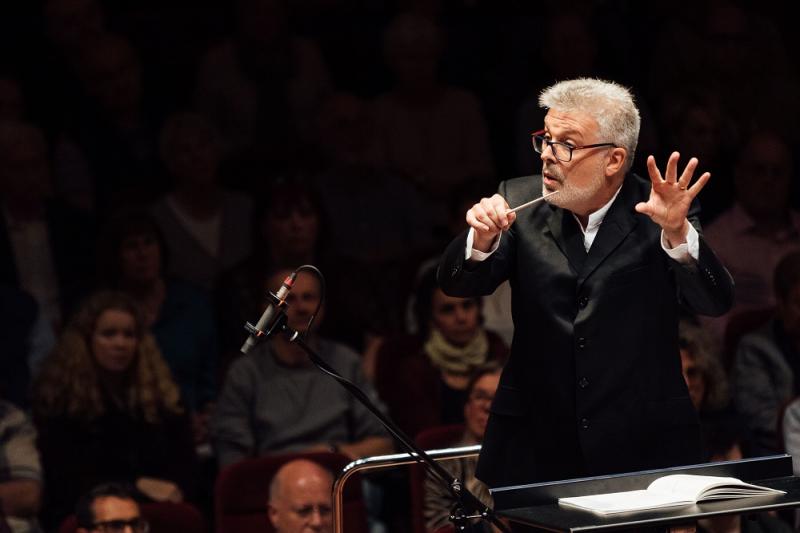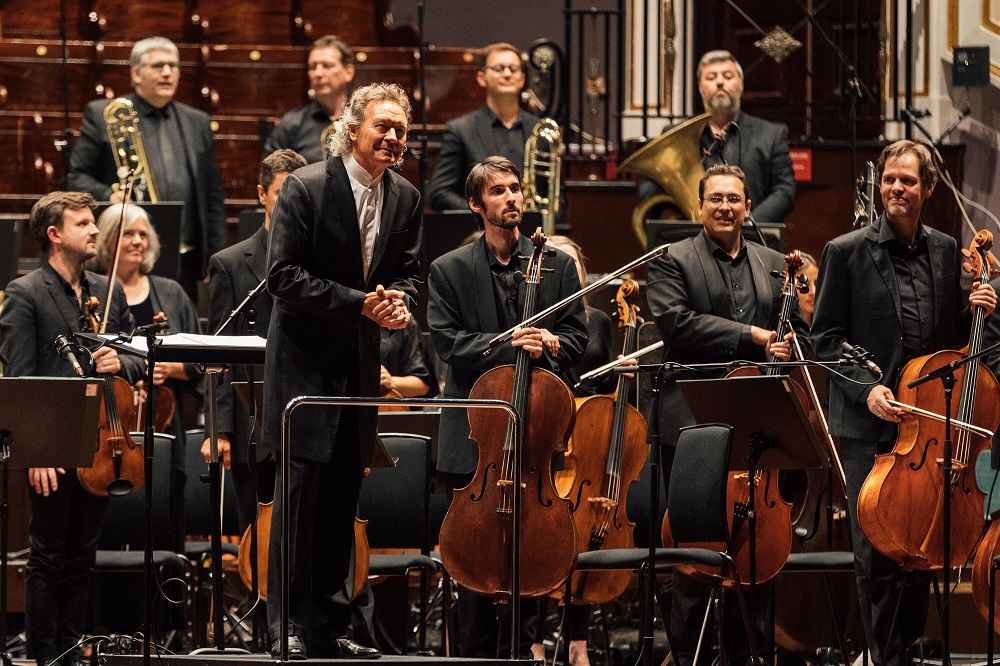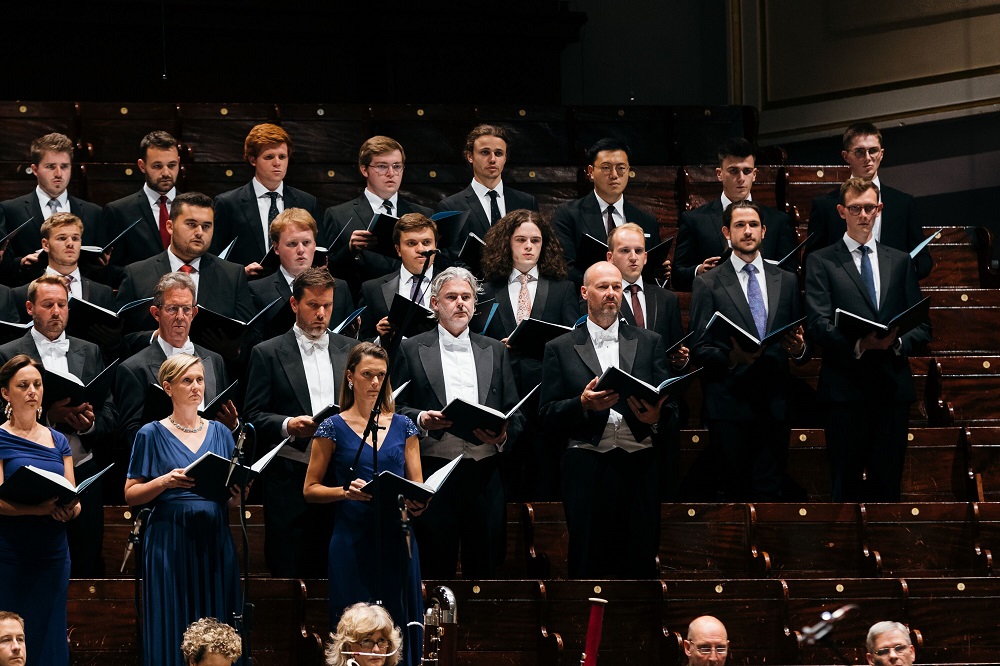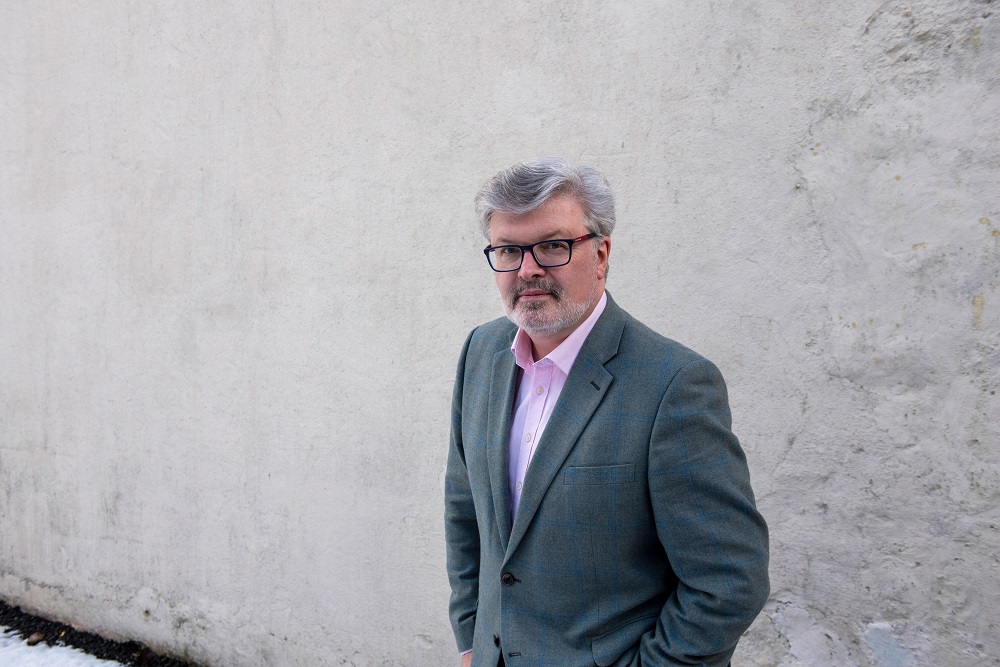Edinburgh International Festival 2019: MacMillan birthday concerts - searing world premiere | reviews, news & interviews
Edinburgh International Festival 2019: MacMillan birthday concerts - searing world premiere
Edinburgh International Festival 2019: MacMillan birthday concerts - searing world premiere
Triumphant new choral symphony for our rudderless times

To celebrate the 60th birthday of Sir James MacMillan, the Edinburgh International Festival has programmed his music over five concerts, including the Nash Ensemble with Fourteen Little Pictures, the National Youth Choir of Scotland with All the Hills and Vales Along, and the Royal Scottish National Orchestra and the Festival Chorus with the cantata Qui
It’s something of a gamble, even in the febrile atmosphere of a festival, to programme a contemporary composer quite so exclusively, but for Edinburgh it was handsomely vindicated – while the earlier concert at 5pm drew a respectable house, the later performance was packed to the rafters with an audience keen to hear the first ever performance of Le grand Inconnu, MacMillan’s Fifth Symphony, an epic choral meditation on the Holy Spirit (★★★★★).
And were they pleased with what they witnessed? You bet. Seldom if ever have I seen the Usher Hall audience, staid at the best of times, rise to its feet to cheer the composer of a new work with such heartfelt enthusiasm. This was music whose dramatic poise and deep poignancy reflects MacMillan’s stature as a figure of cultural and national importance, and not just in Scotland. Is it too much to suggest that in the increasing moral and political vacuum of our affairs of state, we heard in this music the triumphant reassertion of the values of love, tolerance, and hope? It is certainly music of astonishing beauty and clarity, and it was impeccably performed under the baton of Harry Christophers (pictured above) with The Sixteen, Genesis Sixteen (effectively a boot camp for aspiring choristers), and the Scottish Chamber Orchestra. The symphony is broadly elegiac in tone, falling into three movements: "Ruah" (Hebrew for breath), "Zao" (Greek for living water) and "Igne vel Igne" (Latin for fire or fire). The texts come from the Bible, St John of the Cross, and the great creation hymn Veni Creator Spiritus by Rabanus Maurus (famously used in Mahler’s 8th symphony).
It is certainly music of astonishing beauty and clarity, and it was impeccably performed under the baton of Harry Christophers (pictured above) with The Sixteen, Genesis Sixteen (effectively a boot camp for aspiring choristers), and the Scottish Chamber Orchestra. The symphony is broadly elegiac in tone, falling into three movements: "Ruah" (Hebrew for breath), "Zao" (Greek for living water) and "Igne vel Igne" (Latin for fire or fire). The texts come from the Bible, St John of the Cross, and the great creation hymn Veni Creator Spiritus by Rabanus Maurus (famously used in Mahler’s 8th symphony).
The symphony begins imperceptibly with the sound of breathing – albeit interrupted by the clattering of a seat in the upper circle. To me, this conjured the vision of an immense seascape, into which pebbly interjections from the brass brought a feeling of increasing agitation, culminating in a grandiloquent choral setting of the word Ruah. Rhythmically simple, but harmonically dense with microtonal chromaticism, this first passionate outpouring with full orchestra, not unlike "Daybreak" from Ravel’s Daphnis and Chloe, sets the tone for the entire symphony – its melodic breadth and confidence mirrored in the movements to come.
MacMillan has a Mahlerian capriciousness with his use of text – jumbling and jigsawing words from multiple sources and languages to create a seamless flow. But his choral writing is radiant and even if its influences are never far beneath the surface its originality is indisputable. On the word "spiritus", for example, bass voices hold a deep pedal note while the upper voices drift towards that melodic serenity we associate with Hildegard of Bingen. Later in the second movement, a 20-part polyphonic setting of "In novissimo autem" (from John in the Vulgate bible) is an exquisitely beautiful piece of a cappella writing that will almost certainly be picked up by sophisticated choirs seeing to broaden their range.  In the third movement the same applies to arguably an even more gorgeous setting of "O living flame of love" (St John of the Cross), whose only disappointment was that it was not repeated when the words return at the very end of the symphony.
In the third movement the same applies to arguably an even more gorgeous setting of "O living flame of love" (St John of the Cross), whose only disappointment was that it was not repeated when the words return at the very end of the symphony.
As befits a choral symphony, it is the chorus (pictured above) that steals this show; whether on their own, or accompanied, as in the gracious setting of "The wind blows" (John), The Sixteen and their cohorts sounded magnificent. I have made no mention of the four superb soloists drawn from the choir who come forward in the second movement for melismatic and romantic settings of watery words, and little mention of the virtuosic orchestra, a fitting and textural counterpoint to the lavish choral writing. All in all a wonderful piece that I hope to hear again.
With Le grand Inconnu as the climax of the evening, what of the three pieces that preceded it (★★★)? They fade slightly in the memory. At 5pm we heard A Scotch Bestiary (2004), a somewhat cheeky concertante work for organ and very large orchestra (the BBC Scottish under the efficient baton of Joana Carniero), a piece whose chief merit is to show off the capacity of the Usher’s restored Norman and Beard organ not only to create a great wall of sound-filled air but also to make strange barking noises and petulant wheezes using the more obscure stops.  This was followed by Woman of the Apocalypse (2012), a concerto for orchestra inspired by a range of visual art from Rubens to Dürer. Curiously, where the Bestiary was acknowledged as modelled on Musorgsky’s Pictures at an Exhibition, I found the Apocalypse heavy with references to other composers: a Mahlerian opening, a steely grey dawn straight out of Prokofiev’s Alexander Nevsky, and a serpentine Straussian string quartet.
This was followed by Woman of the Apocalypse (2012), a concerto for orchestra inspired by a range of visual art from Rubens to Dürer. Curiously, where the Bestiary was acknowledged as modelled on Musorgsky’s Pictures at an Exhibition, I found the Apocalypse heavy with references to other composers: a Mahlerian opening, a steely grey dawn straight out of Prokofiev’s Alexander Nevsky, and a serpentine Straussian string quartet.
MacMillan (pictured above by Marc Marnie) himself took the baton for his Second Symphony – the first piece in the second concert. Dating from 1999, it is short, but not particularly concise. The orchestration is original – a typical moment might have a single held high string note underpinned by a rumbling bass drum and interweaved by a rollicking clarinet – and there are some interesting side-swipes at Wagner’s Tristan und Isolde, but this is a difficult piece to love, especially when remembered alongside the glorious Fifth.
Share this article
Add comment
The future of Arts Journalism
You can stop theartsdesk.com closing!
We urgently need financing to survive. Our fundraising drive has thus far raised £49,000 but we need to reach £100,000 or we will be forced to close. Please contribute here: https://gofund.me/c3f6033d
And if you can forward this information to anyone who might assist, we’d be grateful.

Subscribe to theartsdesk.com
Thank you for continuing to read our work on theartsdesk.com. For unlimited access to every article in its entirety, including our archive of more than 15,000 pieces, we're asking for £5 per month or £40 per year. We feel it's a very good deal, and hope you do too.
To take a subscription now simply click here.
And if you're looking for that extra gift for a friend or family member, why not treat them to a theartsdesk.com gift subscription?
more Classical music
 First Person: Manchester Camerata's Head of Artistic Planning Clara Marshall Cawley on questioning the status quo
Five days of free events with all sorts of audiences around Manchester starts tomorrow
First Person: Manchester Camerata's Head of Artistic Planning Clara Marshall Cawley on questioning the status quo
Five days of free events with all sorts of audiences around Manchester starts tomorrow
 Goldscheider, Brother Tree Sound, Kings Place review - music of hope from a young composer
Unusual combination of horn, strings and electronics makes for some intriguing listening
Goldscheider, Brother Tree Sound, Kings Place review - music of hope from a young composer
Unusual combination of horn, strings and electronics makes for some intriguing listening
 theartsdesk Q&A: composer Donghoon Shin on his new concerto for pianist Seong-Jin Cho
Classical music makes its debut at London's K-Music Festival
theartsdesk Q&A: composer Donghoon Shin on his new concerto for pianist Seong-Jin Cho
Classical music makes its debut at London's K-Music Festival
 Helleur-Simcock, Hallé, Wong, Bridgewater Hall, Manchester review - moving lyricism in Elgar’s concerto
Season opener brings lyrical beauty, crisp confidence and a proper Romantic wallow
Helleur-Simcock, Hallé, Wong, Bridgewater Hall, Manchester review - moving lyricism in Elgar’s concerto
Season opener brings lyrical beauty, crisp confidence and a proper Romantic wallow
 Kohout, Spence, Braun, Manchester Camerata, Huth, RNCM, Manchester review - joy, insight, imagination and unanimity
Celebration of the past with stars of the future at the Royal Northern College
Kohout, Spence, Braun, Manchester Camerata, Huth, RNCM, Manchester review - joy, insight, imagination and unanimity
Celebration of the past with stars of the future at the Royal Northern College
 Jansen, LSO, Pappano, Barbican review - profound and bracing emotional workouts
Great soloist, conductor and orchestra take Britten and Shostakovich to the edge
Jansen, LSO, Pappano, Barbican review - profound and bracing emotional workouts
Great soloist, conductor and orchestra take Britten and Shostakovich to the edge
 Jakub Hrůša and Friends in Concert, Royal Opera review - fleshcreep in two uneven halves
Bartók kept short, and a sprawling Dvořák choral ballad done as well as it could be
Jakub Hrůša and Friends in Concert, Royal Opera review - fleshcreep in two uneven halves
Bartók kept short, and a sprawling Dvořák choral ballad done as well as it could be
 Hadelich, BBC Philharmonic, Storgårds, Bridgewater Hall, Manchester review - youth, fate and pain
Prokofiev in the hands of a fine violinist has surely never sounded better
Hadelich, BBC Philharmonic, Storgårds, Bridgewater Hall, Manchester review - youth, fate and pain
Prokofiev in the hands of a fine violinist has surely never sounded better
 Monteverdi Choir, ORR, Heras-Casado, St Martin-in-the-Fields review - flames of joy and sorrow
First-rate soloists, choir and orchestra unite in a blazing Mozart Requiem
Monteverdi Choir, ORR, Heras-Casado, St Martin-in-the-Fields review - flames of joy and sorrow
First-rate soloists, choir and orchestra unite in a blazing Mozart Requiem
 Cho, LSO, Pappano, Barbican review - finely-focused stormy weather
Chameleonic Seong-Jin Cho is a match for the fine-tuning of the LSO’s Chief Conductor
Cho, LSO, Pappano, Barbican review - finely-focused stormy weather
Chameleonic Seong-Jin Cho is a match for the fine-tuning of the LSO’s Chief Conductor
 Classical CDs: Shrouds, silhouettes and superstition
Cello concertos, choral collections and a stunning tribute to a contemporary giant
Classical CDs: Shrouds, silhouettes and superstition
Cello concertos, choral collections and a stunning tribute to a contemporary giant
 Appl, Levickis, Wigmore Hall review - fun to the fore in cabaret and show songs
A relaxed evening of light-hearted fare, with the accordion offering unusual colours
Appl, Levickis, Wigmore Hall review - fun to the fore in cabaret and show songs
A relaxed evening of light-hearted fare, with the accordion offering unusual colours

Comments
MacMillan's new symphony. Le
Can't wait: The Sixteen's
Can't wait: The Sixteen's performance of his Stabat Mater there was amazing. Shall duly add as link at bottom of the review.